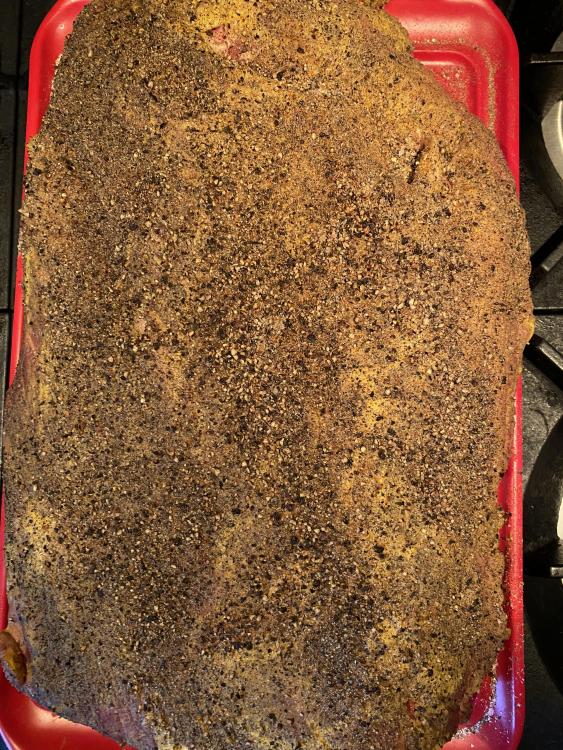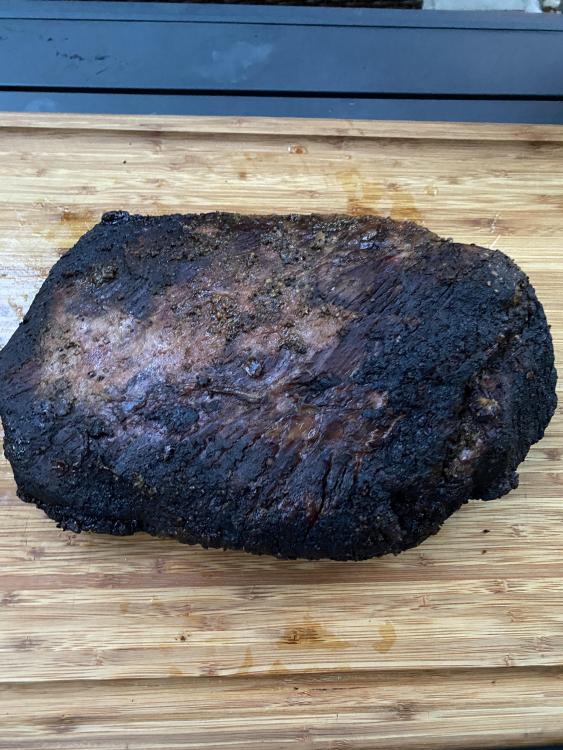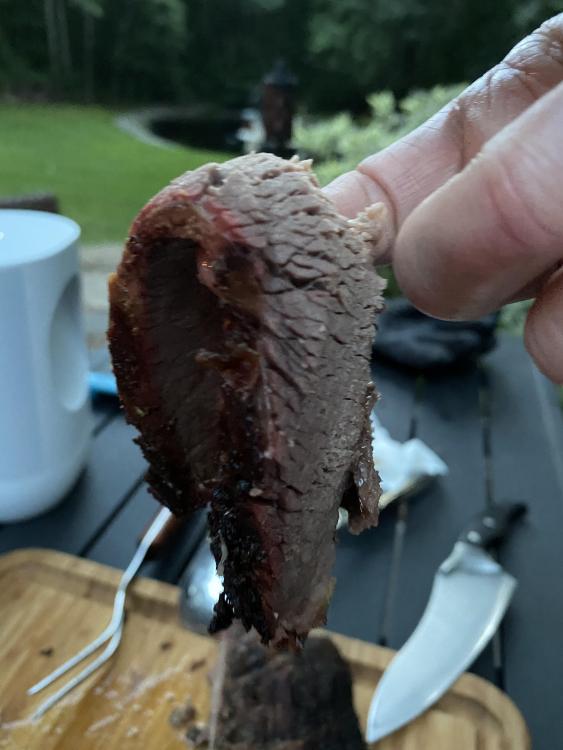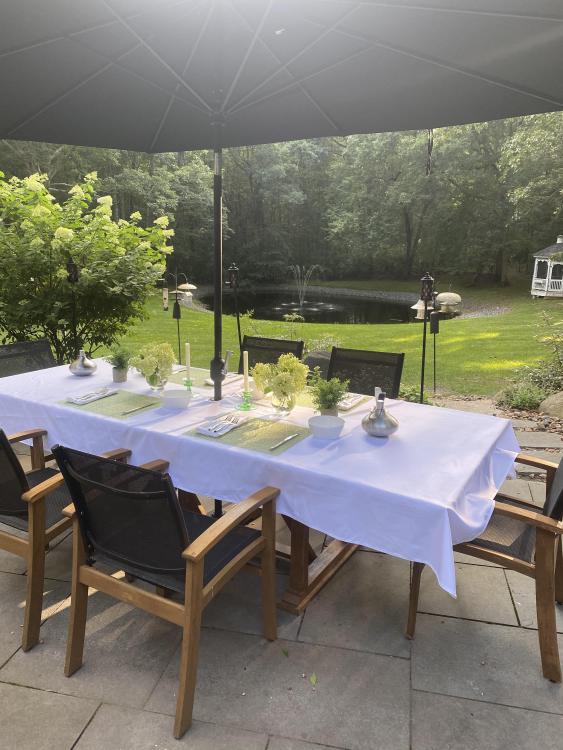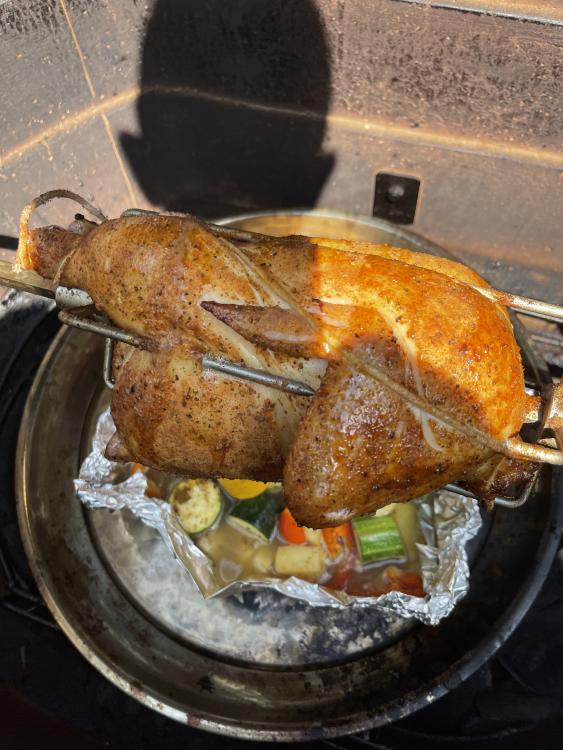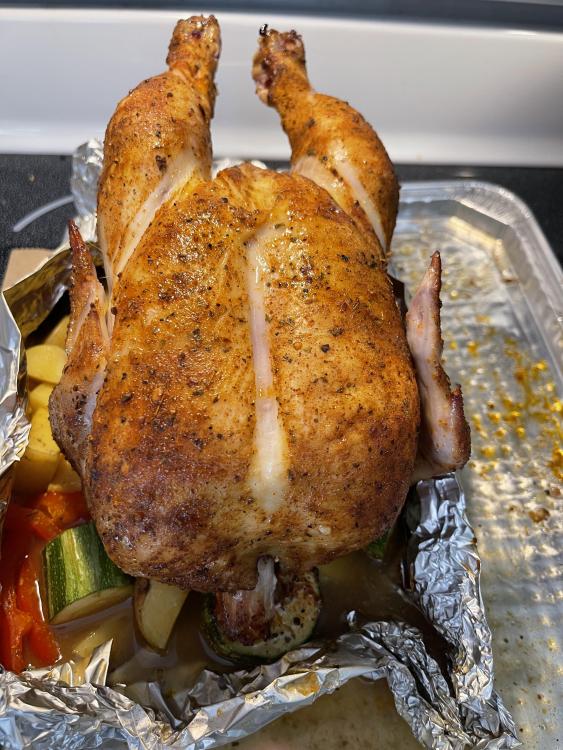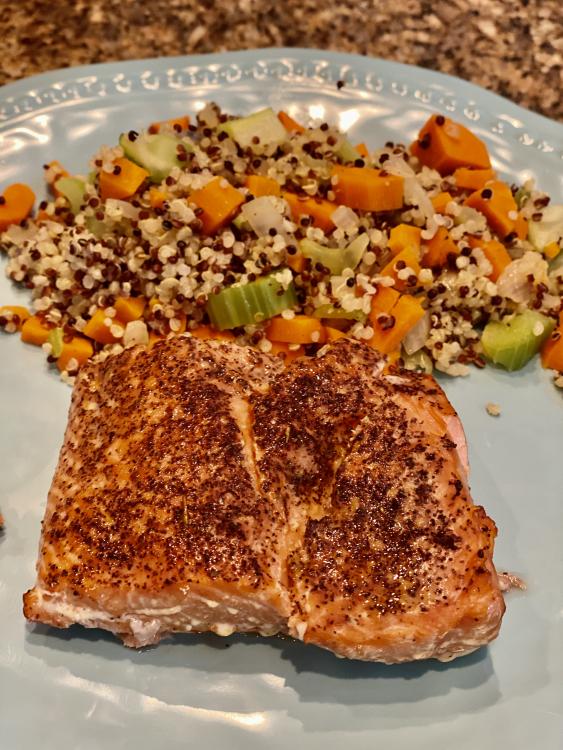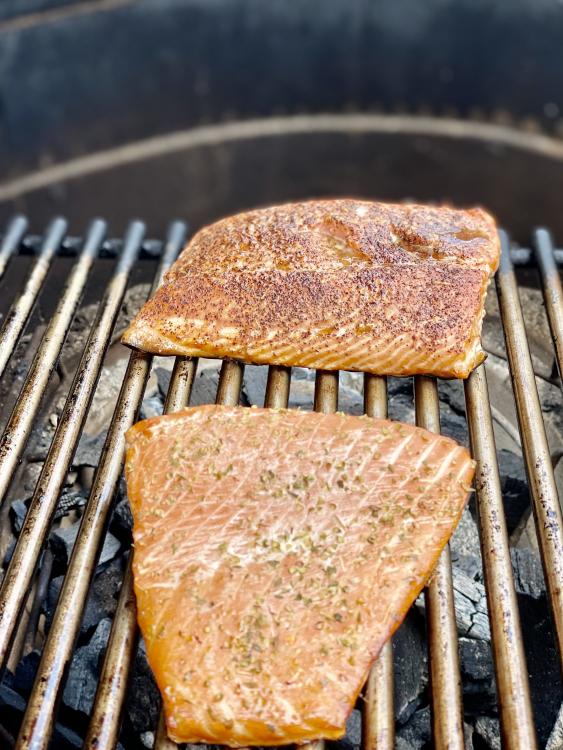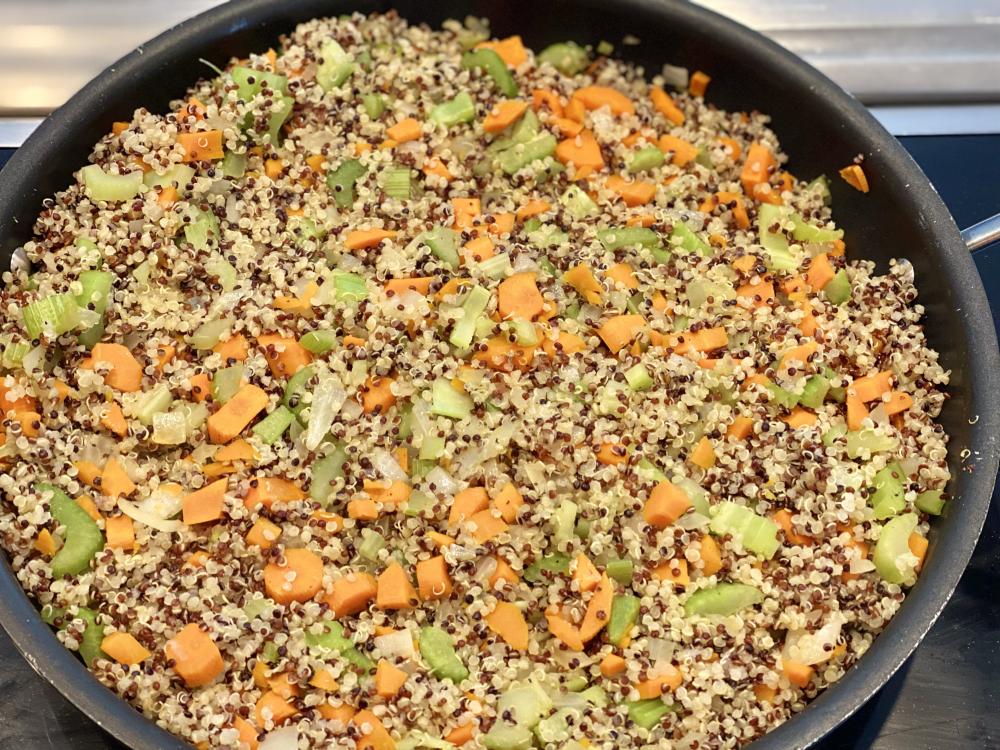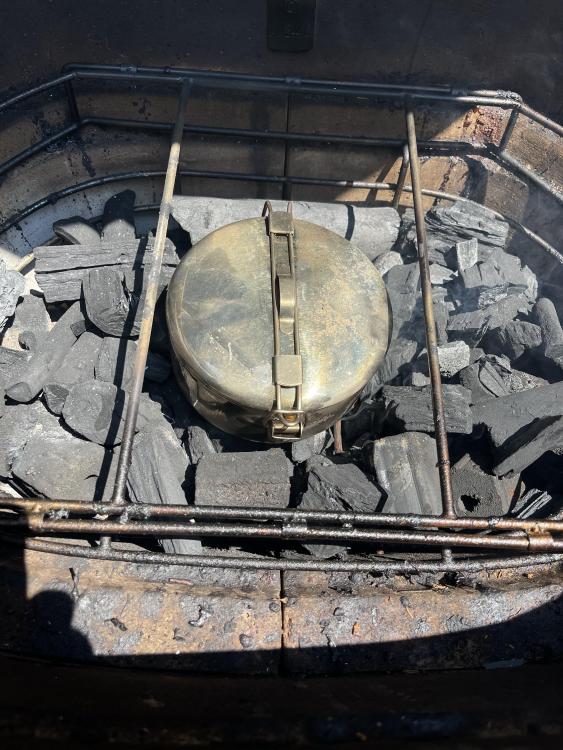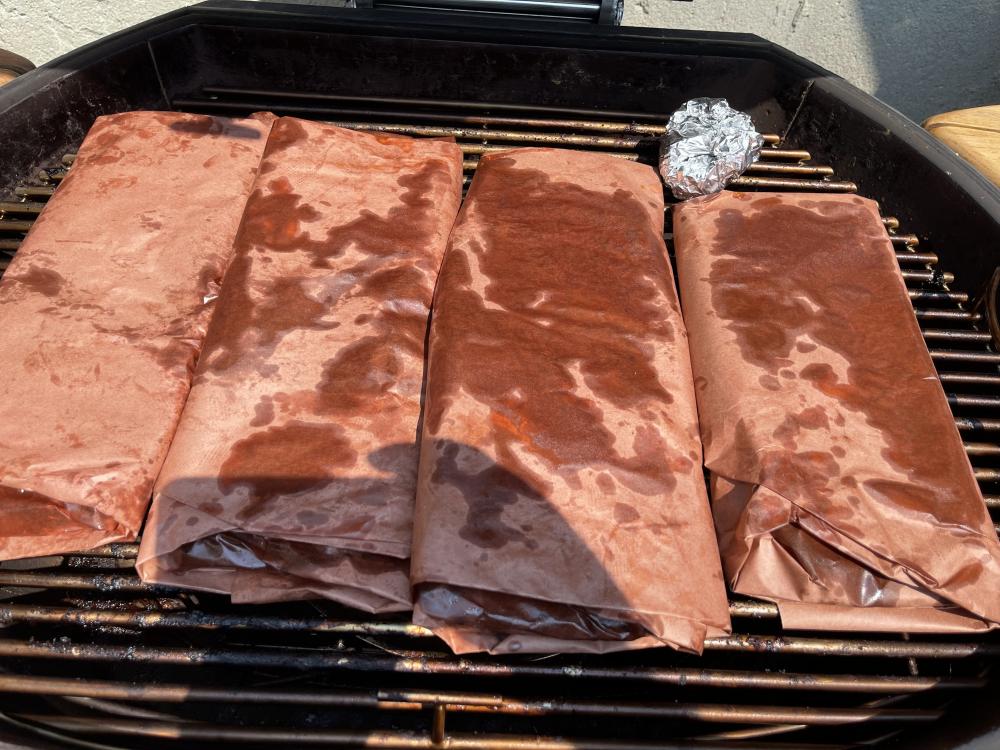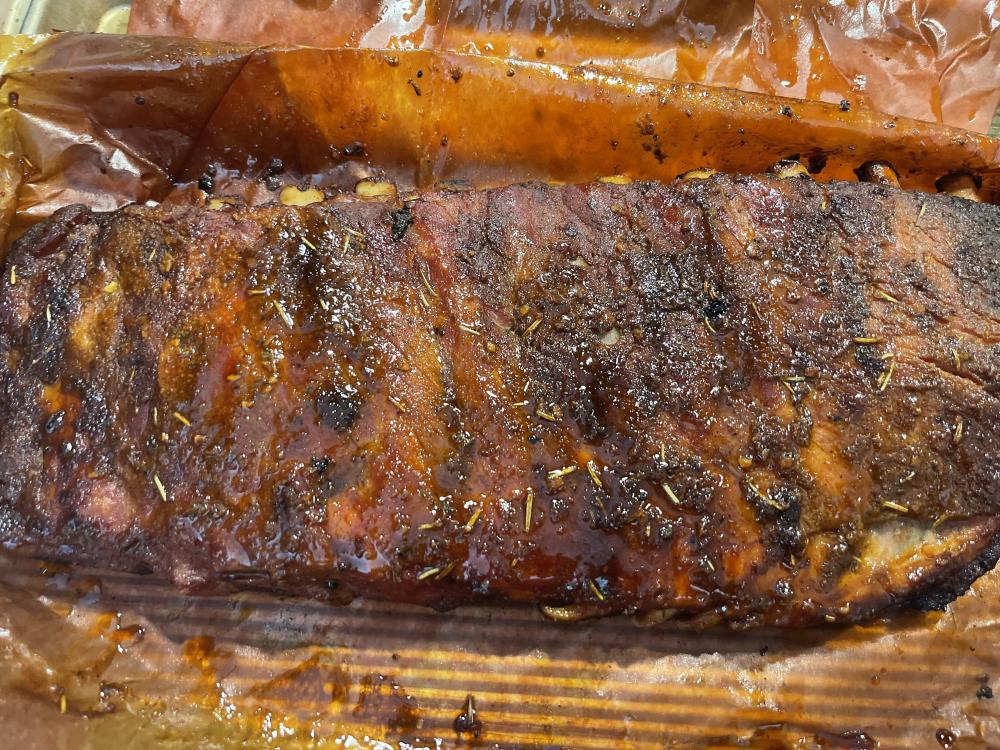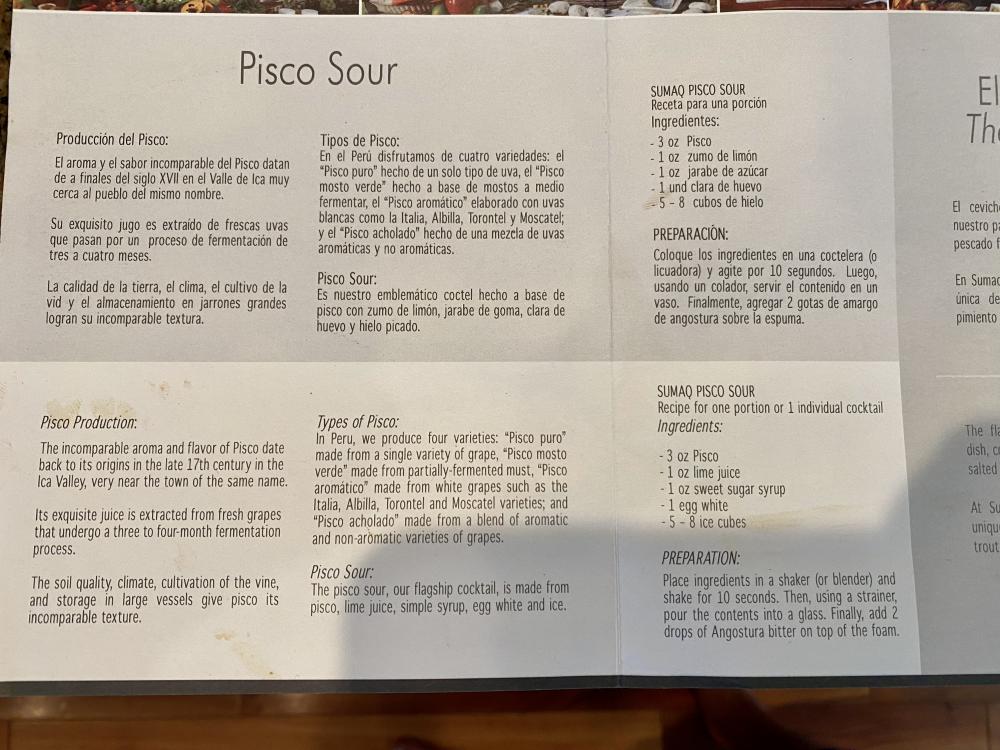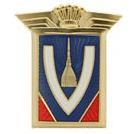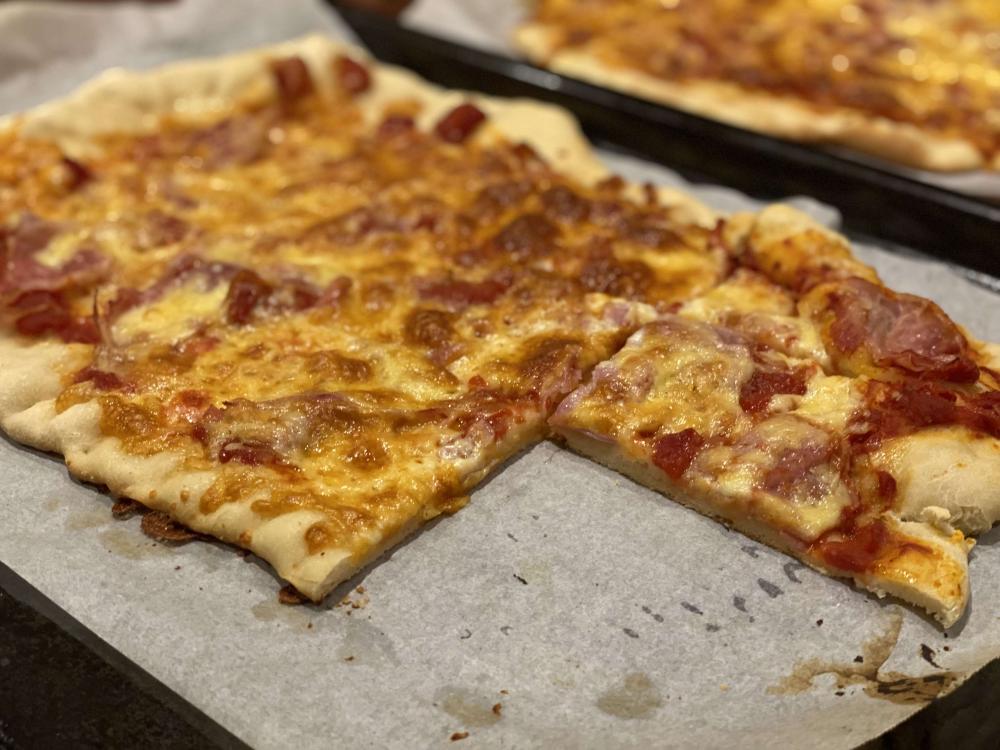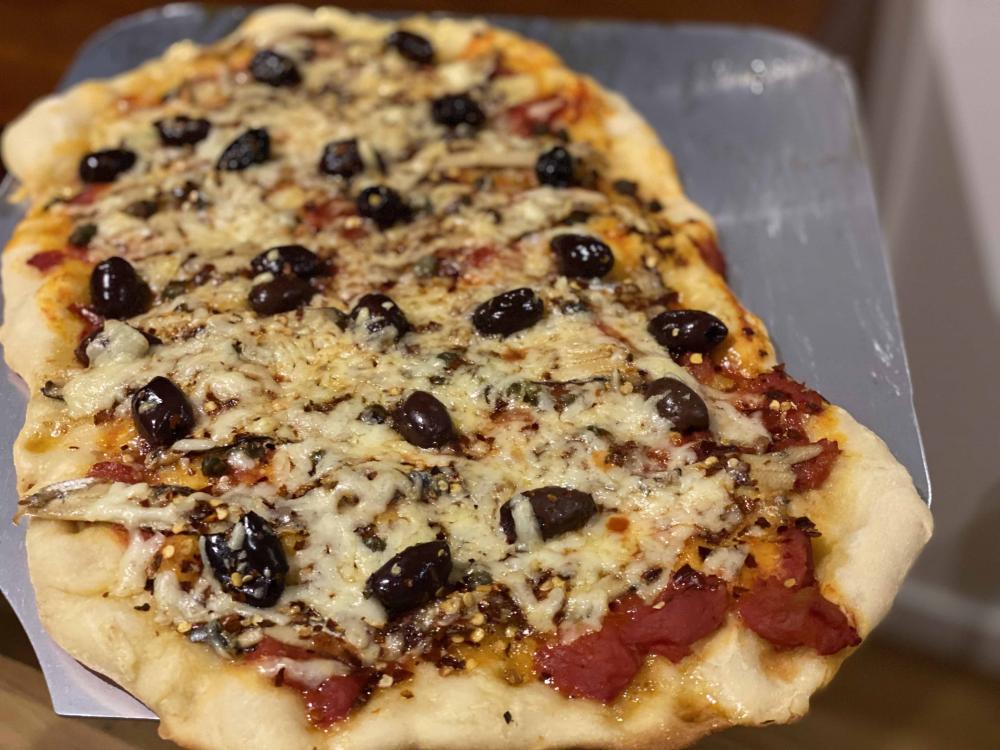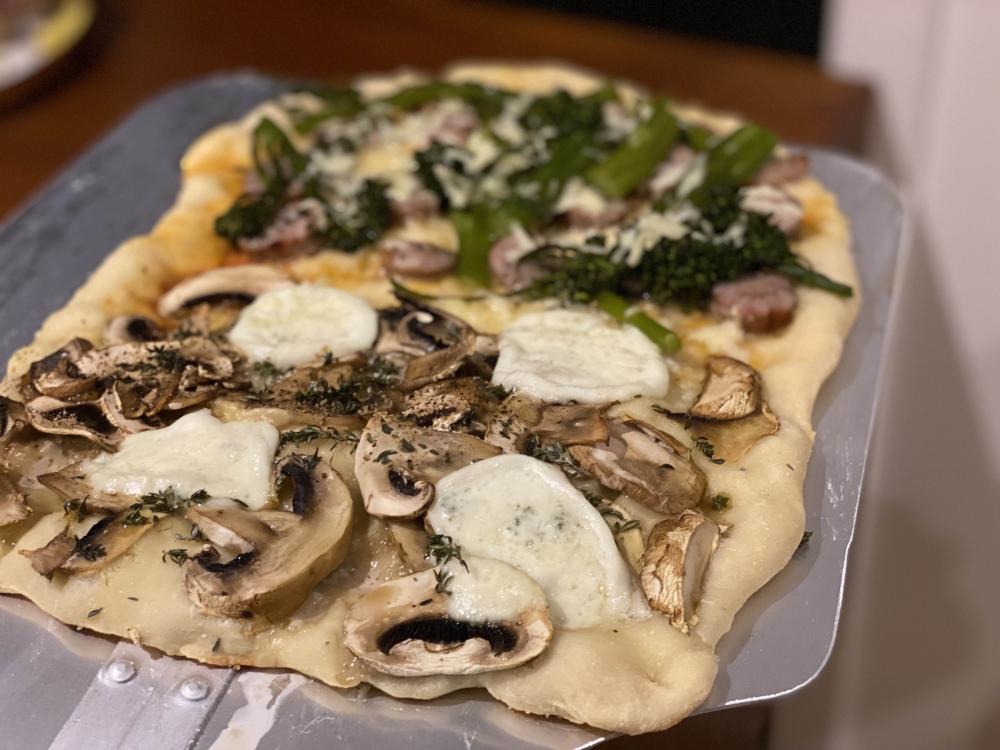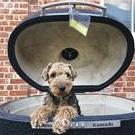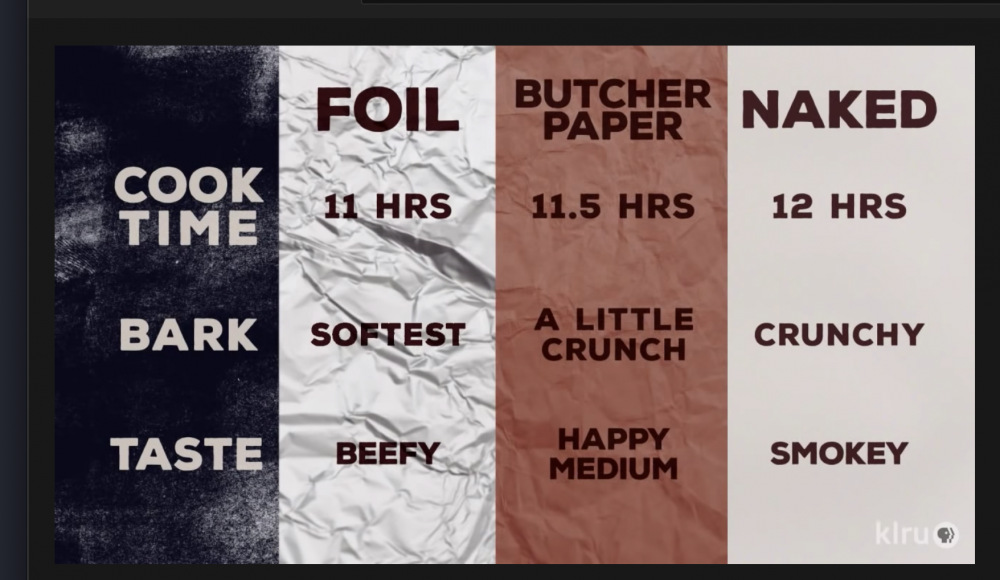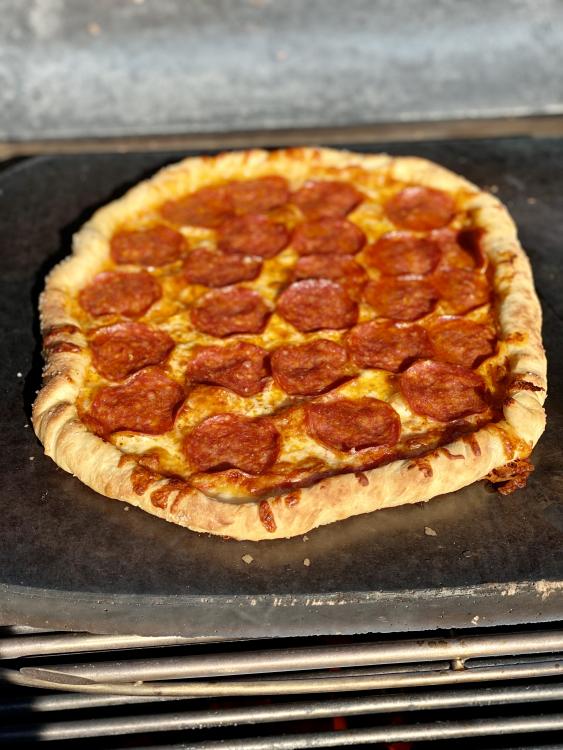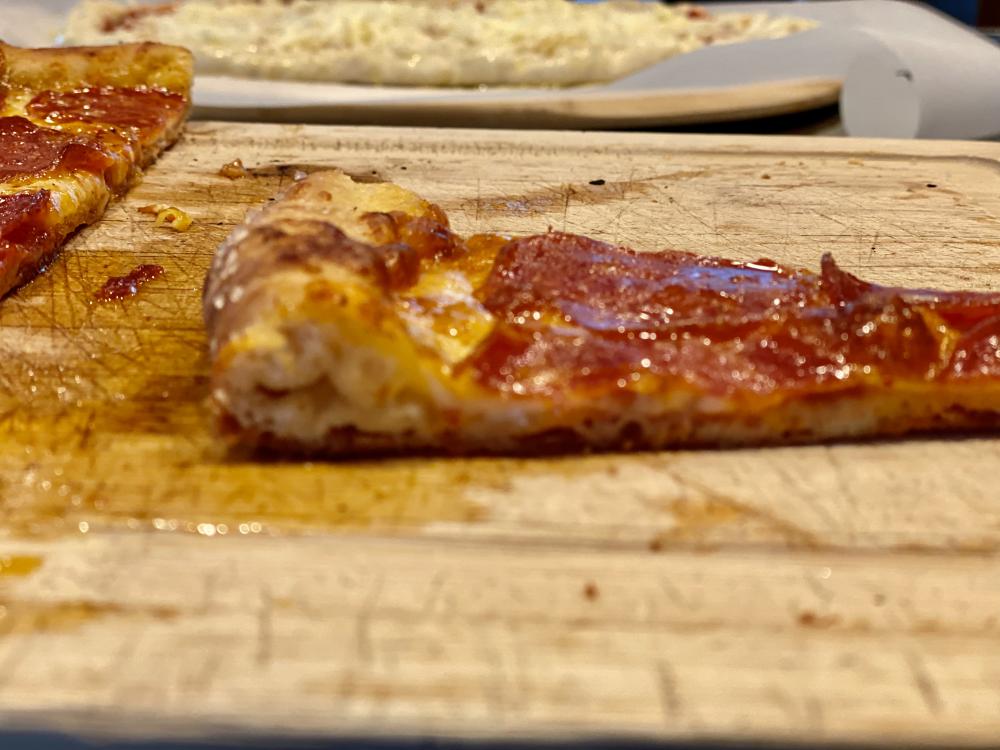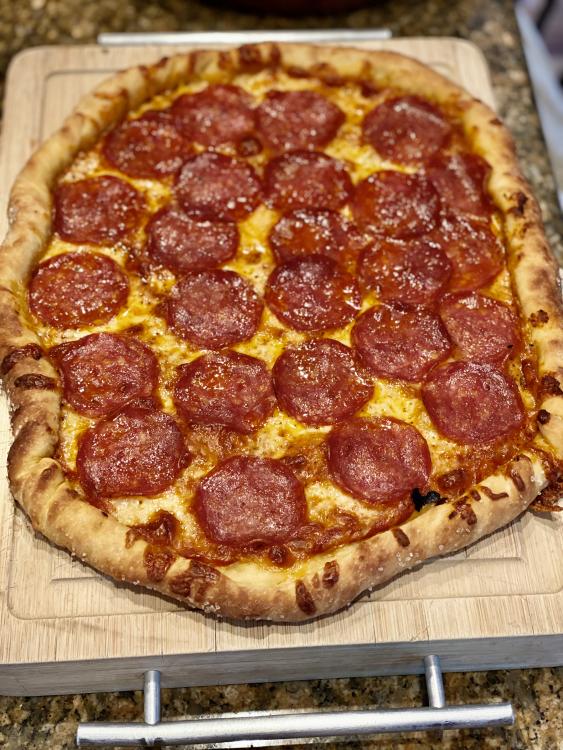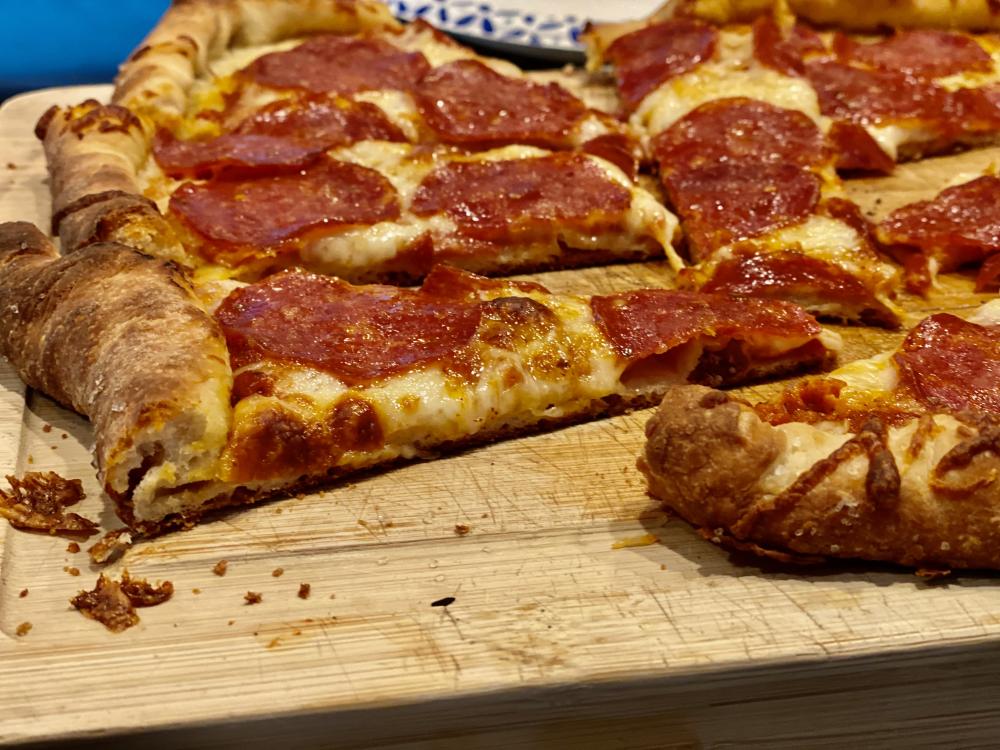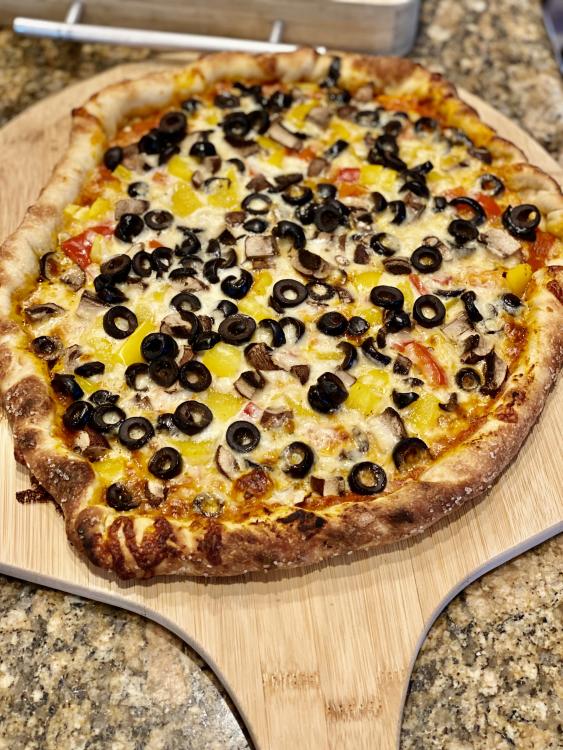Leaderboard
Popular Content
Showing content with the highest reputation on 07/25/2021 in all areas
-
Pizza and wings kind of Saturday. Wings- sprayed with duck fat, seasoned and left overnight. Then smoked with hickory chunks in the smoker pot at ~225F for 95 min. Dial up heat to 350-400F for 30-40 min more. sauce them as you like with hot, honey bbq, garlic park, and Asian zing options. Pictures were an after thought but I got one early in the grill and one late before the last of them. Pizzas - 4, 14-16in. Pies. heat soak KK to 500-525 with baking stone in. Hand toss. Olive oil on parchment paper. Straight on the stone. Remove the paper after 2-3 min and rotate pie. Rotate pie once more 2-3 min later. Done in about 9 min (Pics front to back): - pepperoni, sausage and green olive - honey sriracha chicken with jalapeño. Highly recommend you google this recipe, follow the principle and make your own rendition. - sausage and pepperoni - margarita with pickled onions and reduced balsamic drizzle Sent from my iPhone using Tapatalk5 points
-
Now for the postmortem. The brisket was a big hit. My best ever, according to my wife (yes, I know she’s a little biased). The photos don’t really do it justice. The flat was juicy and the point was absolutely melt in your mouth. The rub was sea salt, pepper, and some cayenne. We started inside with apps - smoked salmon on mustard butter toasts and shrimp. Then outside for dinner, tablescape curtesy of my wife. Started with an intermezzo - lemon sorbetto in Prosecco and grappa. Sides were a hash brown potato casserole (no photo) and a Malaysian fruit and vegetable slaw.5 points
-
Great setting to cook amongst the flowers BOC. We r moving out of home for 3 months while the next renovations get underway so old habits have been a bit disrupted. I did however manage to sneak in a cheeky beef rib slow cooked over 7 hours. I rigged up the Smartfire for a 120c (250f) cook and then took the boys to play rugby. Returned 2 hours later and the temp was rock solid at 120. I threw a few frozen snags in for the last 2 hours and they turned out delish. Sent from my iPhone using Tapatalk4 points
-
4 points
-
Looks good @C6Bill I keep getting the weekly email from the family run fishing boat that they are bringing back CA King Salmon. 4th week in a row. $19/lb delivered to my front door. Boat comes in Friday morning and it’s in my fridge by noon Friday. Can’t beat that. Also picked up 1lb of fresh halibut I’ll make Peruvian Ceviche with & 1lb of bluefin tuna that I’ll do sashimi with. standard salmon cook indirect with mesquite wood. Kids get salt, garlic powder & oregano. Wife & I use this house blend mesquite rub. Served with tri color quinoa sweet onions, celery & carrots with Oyster Bay Sauvignon Blanc. Tasty lunch3 points
-
Decided to try a smoke pot and the pork lard and butcher paper method for ribs the other day. Everyone loved the lighter milder smoke taste and the moisture in the ribs was nice too. I'm sure i will try that method again someday. But the smoke pot is here to stay, i have it in again today with a chicken spinning3 points
-
With the fresh halibut we got yesterday I made a Peruvian ceviche (which I’ve shared the recipe on other threads before) but decided to pair it today with a Pisco Sour 3 parts Pisco 1 part lime juice 1 part simple syrup Egg white topped with a dash of bitters also got this recipe from the Hotel in Agia Calientes (base of Machu Pichu), kept this piece of paper now for 8 years Side note we made this with “Kusi” Pisco which is my wife’s name. Kusi mean happiness in Quechua and whenever her relatives come visit from Peru they always bring us a bottle2 points
-
Yummy looking food, one and all! Trouble is, I am now totally indecisive about what to have for dinner - wings, pizza, fish, chicken, steak...?2 points
-
2 points
-
That’s the way to do it Bill. Well done. Sent from my iPhone using Tapatalk2 points
-
2 points
-
1 point
-
You inspired me. I found our bottle of Ocucaje Pisco and added some to Meyer Lemonade. Too tired after an afternoon of chores to actually mix a fancy drink. Delicious!1 point
-
1 point
-
1 point
-
What a lovely aspect and dinner @braindoc. Those sides and your sorbet sound really good. Bravo.1 point
-
The Musui Kamado (Laurie calls it the "indoor K") is perfect for making ghee. Throw in the butter, set on extra low, leave unattended half an hour or more. The new jar is Marcus Samuelsson's Ethiopian spiced butter, a version made by his wife Maya’s tribe, the Gurage. Ghee with aliums and spices. Incredible aroma. I'm reminded of a fish cookbook from decades ago (I've been unable to identify since) where a Portuguese chef is baffled he has to instruct his staff to put the paprika in fat not water, the best parts of spices are fat soluble. Tonight's recipe also calls for a bit of Madras curry powder. We don't buy curry powder, like Indians we make a custom blend per recipe. I'm looking up what this is. Samuelsson's single best recipe could be his Berbere Spice Blend featured for example in his Black-Eyed Peas with Coconut Milk and Berbere; it's better than bought berbere from upscale sources. So of course we want to make Madras curry powder from scratch. It calls for curry leaves I happen to have just bought... Huh. Curry leaves have an amazing flavor, usually unlocked by tempering in oil, somewhat lost if dried for a spice blend. Huh. The Marcus ghee comes back to me. I should make a Madras curry powder ghee, with generous curry leaves. Huh. I should make a custom ghee for rogan josh, and use sous vide to cook a lamb shank confit. I identify with Samuelsson's trajectory and existential culinary questions. I've been listening to his Yes, Chef: A Memoir that he narrates. I love international food from everywhere, but French technique reaches greater heights than just checking off spice boxes. And whatever I do, my Indian tastes muddy, but my best French gets boring. Samuelsson left his Swedish restaurant to open Red Rooster Harlem, where he applies all of his classic training to world and soul food. I'm reminded of Alex Stupak's Tacos: Recipes and Provocations: A Cookbook where he applies his classic training to tacos.1 point
-
I actually bought a year, during a promotion that lets me gift a year. I haven't made my way to Franklin yet, as I've studied his book, but the other cooking videos are worth the membership. It's fun watching Thomas Keller relax over time. As a fellow teacher, I get distracted analyzing each person's presentation.1 point
-
Franklin does a Masterclass, I bought it. It was extremely informative and when complete you can download the PDF and go back and watch the call again anytime you like. I think i have watched it 4 times lol Aaron Franklin Masterclass1 point
-
Thanks all- so sounds like for the next attempt I'll be careful to clear out all old ash, and pay more attention to size and distribution of lump. Great tips.1 point
-
1 point
-
I'm going to make myself unpopular amongst the KK devotees here but we debated a pizza oven despite owning a 32 and 19KK. We have a pizza stone for each and a baking steel and have been able to produce consistently excellent pizzas. 12.5% gluten flour is your friend. We've never really made much pizza in the KK since the pizza oven arrived (Alfa Forni). The oven is quicker, more convenient and consumes less fuel. Being able to see the pizza cooking and being able to judge when to turn it is much better than relying on spidey sense to know when to open the KK. Having said that, with experience, you learn how far to open and how quickly to check on the pizza without losing all the heat in the dome. I bought a Fluke 62 Max IR thermometer (recommended like most of what Fluke make) and it taught me a few things about the temperature and hot spots on the stone. What I learned from the pizza oven, I applied to the KK and I'd say that on balance, the pizza oven is more forgiving but you can achieve similar results in the KK. Irrespective of what you use, I highly recommend GI Metal pizza peels as being a KK build quality standard product. We have a rectangular perforated and a turning peel, they're both a joy to use. Also of interest if you're into pizza is Modernist Pizza - due to arrive in September. Looking forward to seeing what I can learn from it.1 point
-
How to get Kamado hot 500F°+ -Remove any items or debris from the lower intake vent (e.g. ash catcher, small charcoal pieces, etc.) -Make sure the bottom of your firebox is well aligned with your lower intake vent. -Store your charcoal inside away from the wet elements. Only use dry fuel. -Use lump charcoal, it will get a lot hotter then briquettes or extruded charcoal and produce less ash. -Don’t blame your brand of lump charcoal, all major lump brands are capable of producing high heat temps for cooking pizza. -Deliberately build your fire: * Keep in mind small pieces of lump burn hotter however they also restrict airflow. * Larger pieces won’t burn quite as hot but they promote airflow. * Airflow = Heat * Airflow restriction is the primary factor preventing you from getting your Kamado to pizza cooking temperatures. * Do not pour your charcoal directly into your firebox, small pieces of lump can fall into the bottom of your firebox and block free airflow. * Lay your lump charcoal out in a wide mouthed bin. * Sort your lump by large, medium, and small pieces. * Discard any really small lump pieces and the dust that settles at the bottom. * Deliberately build your fire box to promote free airflow. * Start with large chunks (fist size or larger) place them one by one at the bottom of your firebox until you have a complete layer of large chunks on the bottom of your charcoal basket. * Now light your layer of large lump pieces. I prefer using a torch until I get a visual flame coming off of two spots of the large lump pieces. * Once your large lump is lit continue building your lump pile by using medium pieces on top of the large lit coals, lay them on top in such a way they don’t interlock with each other and block airflow. * Fill your firebox to the brim with medium lump atop the large chunks at the bottom. Cooking at high temperatures requires a lot of fuel. If you do not use enough lump your fire will run out of steam. * Optionally, you can place some smaller pieces of lump at the very top of your charcoal basket on top of the medium pieces. Don’t use too many small pieces and ensure they don’t fall down into your firebox. * Again, light several more spots on top of your now fully filled firebox, I recommend lighting until the charcoal is glowing in at least four different additional spots. * Once your fire has been built for airflow and is lit remove any platesetters, fire deflector plates, or any larger objects in your Kamado blocking the free airflow of convective and radiant heat up into the dome. * Close your Kamado lid. * Open your bottom vent completely. * Open your top vent nearly fully open, the more your top vent is open the stronger vacuum airflow will be created making your fire burn hotter. However, if you completely remove the top vent then you also allow some of the hot convective air to escape rather then being trapped in the dome so there is a fine balance, explore this with your own grill. * I like to let the grill heat soak for at least 1/2 hour at a temperature of 50 degrees above my intended cooking temperature. * Time is your freind, I recommend starting this process 2 hours before your intended cook time. Rushing things will lead to unsatisfactory results. * Once you’ve allowed sufficient time for the dome to heat soak open you grill and set up your pizza cook with your stone and deflectors if you are using such. Close you lid once again. * Keep your grill lid open as minimally as possible. You will lose some heat after installing your deflectors, let your Kamado stabilize once again at your cooking temperature for at least 15 minutes without adjusting vents. * Place your pizza on your stone. * Check on your pizza as infrequently as possible, you want to retain dome heat for cooking your toppings. * Burp your grill dome before opening. *Additional tips -You can pre-heat your pizza stone in your oven while you grill is heating up. -An infrared temperature gun is a good idea, this will allow you to determine if your stone is to temp before placing your pizza on. -A fan such as the BBQ dragon, a hair dryer, or leaf blower can force air into your lower vent speeding up this whole process. Getting your Kamado hot too fast can put additional stress on your ceramics. -Beer helps. Sent from my iPhone using Tapatalk1 point
-
1 point
-
1 point
-
It always helps to consider the source, and how their requirements are different than yours. Thomas Keller calls for quick 10% salt brines for seafood? In a restaurant kitchen there isn't room for an overnight "equilibrium" 0.5% brine. At home that same brine lets you buy fish for several days. Most recipes are really dumbed down, and most people spread techniques that are only partially evolved. And a popular author could be aware that readers have foil, but they don't have pink (uncoated! white is coated, wrong) butcher paper. Do they say something? I would only trust a source recommending foil if they explicitly make the comparison with pink butcher paper, and explain why they prefer foil. Aaron Franklin is arguably the most deservedly famous barbecue guru today. He's primarily a restauranteur, not a "personality", so he's freed from a financial incentive to dumb down his advice. On the contrary, there's a showstopper chapter "Building a Smoker" in Franklin Barbecue: A Meat-Smoking Manifesto [A Cookbook], how anyone can make their own cooker from a recycled 500 gallon propane tank with "basic metalworking skills". I can do most things but this is still on my list... He faces a restaurant constraint, perfect for you: All of his cookers run at 275°. Why? He prefers this to lower temperatures, gets better throughput, and doesn't have to juggle capacities of cookers set to different temperatures. He gives the clearest directions I've seen anywhere for cooking a 12 to 14-pound packer cut brisket, wrapping at 6 hours or so in pink butcher paper. I've varied my approach over the years: Temperature, wrapping, beef source, dry age? I believe that following exactly Aaron Franklin's protocol is spot-on. For a different opinion, in Brisket Tricks and elsewhere, @mguerra has been advocating for 325° or so. What you propose is decidedly not "hot and fast". 275° is reasonable middle ground, not falling prey to equating seriousness of intent with slowness of cook. The very idea that "low & slow" is such a sticky idea should serve as a warning not to take it as gospel. On the contrary, another of my favorite BBQ books is Legends of Texas Barbecue Cookbook: Recipes and Recollections from the Pitmasters. I don't follow any of the recipes, but I learned a lot about the diversity of approaches in Texas. It freed me from a blind adherence to "low & slow". I believe that the most important factor in brisket is the beef itself. I'll travel an hour and pay three times what others consider reasonable to buy brisket from the Golden Gate Meat Company in San Francisco. They'll dry age a few days on request. I also believe that the ideal cooker temperature is a function of the quality of the meat: 275° for the meat that takes an hour's drive and serious cash, varying up to 325° for more typical and affordable briskets. When there's less collagen/whatever to dissolve, time is your enemy. I no longer cook any brisket at 225°. I've never eaten at Franklin's Barbecue, but the best brisket I've had in my life was in Elgin, Texas. (#2, #3, #4 would be my own.) They can source better brisket in Texas, the market demands it. It melts, you want to spread the fat cap on toast like marmalade. Aaron Franklin's advice is tuned to Texas brisket sources. For potential owners, let me be clear that while Aaron Franklin uses an entirely different cooker, my own preferences are adapted to a Komodo Kamado. Compared to other ceramic cookers, a KK is far better insulated, so it maintains temperature with far less airflow. Airflow dries the meat out. Franklin's 1000 gallon cookers are good guides for us, because with scale he also controls evaporation.1 point
-
I'd stick with the butcher paper. I'm not a fan of wrapping in AL foil, as it softens the bark too much - IMHO.1 point
-
1 point


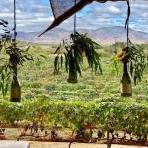
Bull.thumb.jpg.50d347aabd71178c9d9a16b7663cfa1a.jpg)

